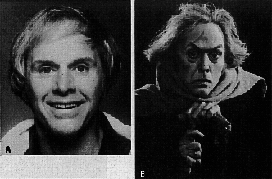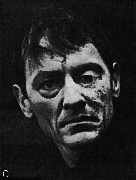Back
to Costume Design Part 2
Costume Design Part 3
Make-up Design
Sometimes make-up is designed by the costumer, sometimes there is a
separate make-up designer, and sometimes actors are responsible for their
own stage make-up. In shows with more complex make-up needs, a make-up
designer is more hired.
Make-up has three purposes on the stage: 1) to make the
actor's features visible, 2) to create character, and 3)
corrective purposes.
Because stage lights tend to wash out an actor's face and because greater
distances between spectators and actors makes visibility difficult, all
actors wear makeup on stage. A base gives the face color and
evens out the facial tones; stage bases may be water-based, greasepaint,
or pan sticks. Eyeliner and rouge for the lips and
cheeks are also used by all actors. While greater distances call
for more saturated colors, in a smaller theatre actors will use less make-up
and colors that resemble their natural tones.
Makeup may also be used to create a character.  Smaller
character effects include changing the shape of eyes or eyebrows, aging
the face and hands, or adding facial hair. Different countries and time
periods also had different notions of beauty; by following these with make-up
design, make-up can help to establish period and time for a character.
Consider silent film actress Clara Bow's "bow" shaped lips, or the heavy
liner and bright colors used on the eyelid by women of the 1950's.
Larger effects may be created with putty or prosthetic devices (latex
foam or plastics), such as building up the nose and chin with putty for
the Wicked Witch of the West in The Wizard of Oz, or building entire
prosthetic heads and limbs for the Teenage Mutant Ninja Turtles.
Other character effects might be bruising, bulletholes, scars, or disfigurements.
Smaller
character effects include changing the shape of eyes or eyebrows, aging
the face and hands, or adding facial hair. Different countries and time
periods also had different notions of beauty; by following these with make-up
design, make-up can help to establish period and time for a character.
Consider silent film actress Clara Bow's "bow" shaped lips, or the heavy
liner and bright colors used on the eyelid by women of the 1950's.
Larger effects may be created with putty or prosthetic devices (latex
foam or plastics), such as building up the nose and chin with putty for
the Wicked Witch of the West in The Wizard of Oz, or building entire
prosthetic heads and limbs for the Teenage Mutant Ninja Turtles.
Other character effects might be bruising, bulletholes, scars, or disfigurements.
Corrective makeup is used to help an actor look his or her best
on stage. The actor uses highlight and shadow to enhance the bone
structure and features of the face toward standard proportions.
For both character and corrective makeup, the most common techniques
are highlighting/shadowing and stippling. Highlighted
areas will stand out, whether or not they follow the normal structure of
the face, and shadowed areas will recede from view.  Stippling
is pressing the makeup onto the face rather than wiping it, and it is used
to give texture to the face and to blend together areas that have been
highlighted and shadowed extensively. Alone, it can be used to create
a "5 o'clock shadow." Stippling may be done with sponges or brushes.
Stippling
is pressing the makeup onto the face rather than wiping it, and it is used
to give texture to the face and to blend together areas that have been
highlighted and shadowed extensively. Alone, it can be used to create
a "5 o'clock shadow." Stippling may be done with sponges or brushes.
End of Costume Designer readings
BACK TO BLOOD'S COURSE MATERIAL
HOME PAGE
 Smaller
character effects include changing the shape of eyes or eyebrows, aging
the face and hands, or adding facial hair. Different countries and time
periods also had different notions of beauty; by following these with make-up
design, make-up can help to establish period and time for a character.
Consider silent film actress Clara Bow's "bow" shaped lips, or the heavy
liner and bright colors used on the eyelid by women of the 1950's.
Larger effects may be created with putty or prosthetic devices (latex
foam or plastics), such as building up the nose and chin with putty for
the Wicked Witch of the West in The Wizard of Oz, or building entire
prosthetic heads and limbs for the Teenage Mutant Ninja Turtles.
Other character effects might be bruising, bulletholes, scars, or disfigurements.
Smaller
character effects include changing the shape of eyes or eyebrows, aging
the face and hands, or adding facial hair. Different countries and time
periods also had different notions of beauty; by following these with make-up
design, make-up can help to establish period and time for a character.
Consider silent film actress Clara Bow's "bow" shaped lips, or the heavy
liner and bright colors used on the eyelid by women of the 1950's.
Larger effects may be created with putty or prosthetic devices (latex
foam or plastics), such as building up the nose and chin with putty for
the Wicked Witch of the West in The Wizard of Oz, or building entire
prosthetic heads and limbs for the Teenage Mutant Ninja Turtles.
Other character effects might be bruising, bulletholes, scars, or disfigurements.
 Stippling
is pressing the makeup onto the face rather than wiping it, and it is used
to give texture to the face and to blend together areas that have been
highlighted and shadowed extensively. Alone, it can be used to create
a "5 o'clock shadow." Stippling may be done with sponges or brushes.
Stippling
is pressing the makeup onto the face rather than wiping it, and it is used
to give texture to the face and to blend together areas that have been
highlighted and shadowed extensively. Alone, it can be used to create
a "5 o'clock shadow." Stippling may be done with sponges or brushes.